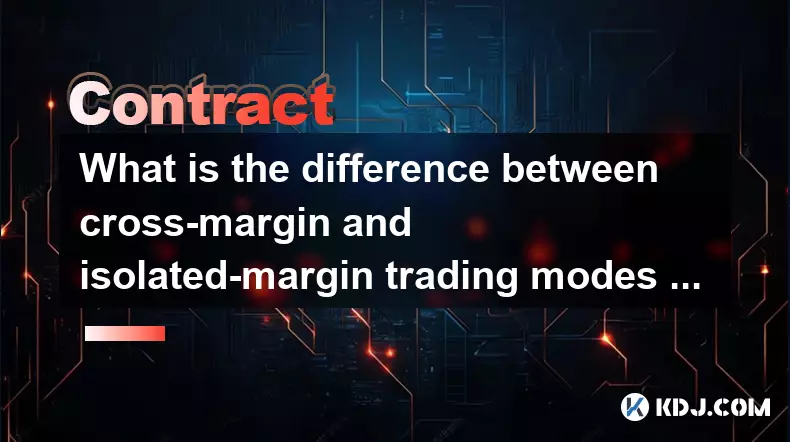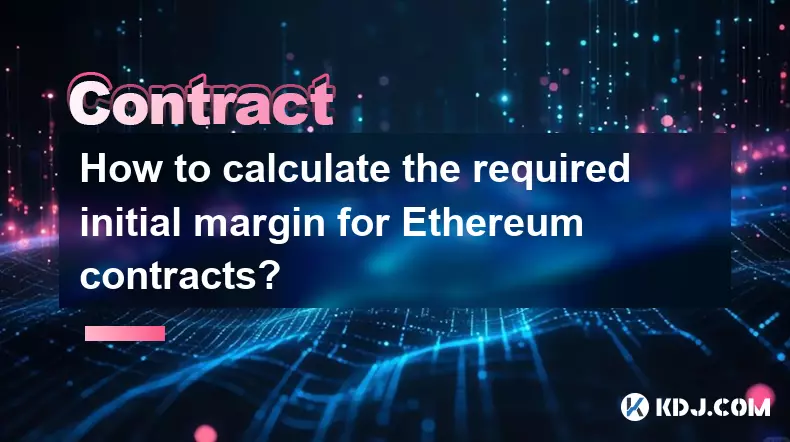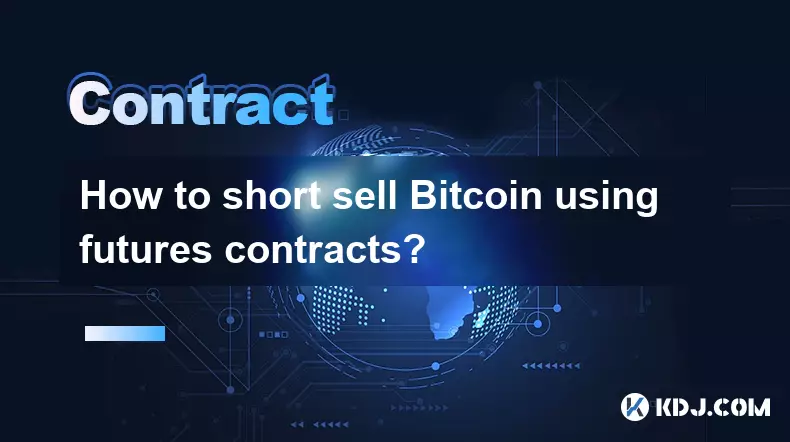-
 bitcoin
bitcoin $118548.520763 USD
3.67% -
 ethereum
ethereum $4352.564943 USD
4.79% -
 xrp
xrp $2.964058 USD
4.22% -
 tether
tether $1.000565 USD
0.05% -
 bnb
bnb $1028.372955 USD
1.46% -
 solana
solana $221.373507 USD
6.00% -
 usd-coin
usd-coin $0.999933 USD
0.02% -
 dogecoin
dogecoin $0.248633 USD
6.85% -
 tron
tron $0.341444 USD
2.38% -
 cardano
cardano $0.852946 USD
5.82% -
 hyperliquid
hyperliquid $47.869306 USD
6.15% -
 chainlink
chainlink $22.561476 USD
6.01% -
 ethena-usde
ethena-usde $1.001258 USD
0.05% -
 avalanche
avalanche $30.660000 USD
2.06% -
 stellar
stellar $0.400917 USD
9.76%
What is the difference between cross-margin and isolated-margin trading modes for TRON (TRX) contracts?
Isolated-margin limits risk to allocated funds per TRX trade, while cross-margin uses total balance, increasing exposure but boosting capital efficiency.
Sep 27, 2025 at 01:36 pm

Cross-Margin vs Isolated-Margin in TRON (TRX) Contracts
1. In cross-margin mode, the entire wallet balance is used as collateral for open positions. This means that all available funds in the account support active TRX contracts, increasing the likelihood of avoiding liquidation under volatile market conditions. The system automatically allocates equity across positions, making risk distribution broader but less controllable per trade.
2. Isolated-margin mode assigns a fixed amount of margin to each individual TRX contract. Traders determine how much capital to allocate, limiting potential losses to only the designated margin. This provides greater control over exposure and enables strategic risk segmentation across multiple positions.
3. Liquidation behavior differs significantly between the two modes. In cross-margin, liquidation occurs only when the total account equity falls below the maintenance threshold. In isolated-margin, each position is evaluated independently, so one contract can be liquidated without affecting others.
4. Cross-margin offers higher capital efficiency by leveraging the full balance, which can amplify gains during favorable moves. However, this also increases systemic risk because a sharp adverse move in any single position may jeopardize the entire account.
5. Isolated-margin allows traders to define precise leverage levels per position. For example, a trader might apply 20x leverage on one TRX futures contract and 5x on another, tailoring risk profiles according to specific strategies or market outlooks.
Risk Management Implications
1. Using cross-margin requires constant monitoring of overall account health. A sudden downturn in TRX price can trigger cascading effects, especially if multiple leveraged positions are open simultaneously.
2. Isolated-margin reduces complexity in risk assessment since each position operates within predefined boundaries. Losses are capped at the allocated margin, enabling more predictable downside scenarios.
3. Traders employing hedging strategies often prefer isolated-margin because opposing positions do not share margin resources. This prevents unintended offsetting due to shared equity pools.
4. Position sizing becomes critical in isolated-margin mode. Allocating too little margin increases the chance of early liquidation, while excessive allocation reduces capital flexibility for other trades.
5. Cross-margin suits experienced traders with diversified portfolios who rely on aggregated equity strength. It performs well in trending markets where portfolio gains offset individual losses.
Impact on Trading Strategy Execution
1. Scalpers and short-term traders frequently use isolated-margin to execute high-turnover strategies with defined risk parameters. Each trade stands alone, simplifying performance tracking and adjustment.
2. Long-term holders using perpetual contracts to hedge spot TRX holdings may favor cross-margin for its resilience during temporary drawdowns. The integrated equity buffer helps sustain positions through volatility spikes.
p>3. Isolated-margin supports multi-strategy deployment on the same asset. One trader could run a long bias on TRX with 10x leverage while running a separate short-term mean reversion setup with 5x leverage, each with distinct margin assignments.
4. Funding rate considerations differ subtly between modes. In cross-margin, negative funding rates drain from the general pool, whereas in isolated-margin, the cost directly impacts the assigned margin, potentially accelerating liquidation if unmonitored.
5. Platform-specific rules affect margin mode selection. Some exchanges impose stricter requirements on cross-margin accounts, including minimum balance thresholds or restricted access during extreme volatility.
Liquidation Mechanics and Margin Buffering
1. In isolated-margin, the liquidation price is calculated solely based on entry price, leverage, and allocated margin. This creates transparency and predictability in worst-case scenarios.
2. Cross-margin recalculates effective leverage dynamically as profits or losses accrue across all positions. This can lead to unexpected shifts in liquidation pricing even if the underlying TRX price remains stable.
3. Auto-deleveraging events primarily affect cross-margin users during exchange-level liquidity crises, as their positions are larger in aggregate and tied to systemic solvency.
4. Isolated-margin positions benefit from clearer buffer zones. Traders can add margin manually up to a limit, postponing liquidation without altering other open contracts.
5. Partial liquidations occur more frequently in isolated-margin setups. Exchanges typically close portions of the position incrementally rather than terminating the entire contract at once.
Frequently Asked Questions
Can I switch between cross-margin and isolated-margin after opening a TRX contract?Most platforms require selecting the margin mode before entering a position. Switching afterward is generally not allowed to prevent manipulation of liquidation risks.
Does isolated-margin allow borrowing additional funds for a specific TRX trade?No, isolated-margin uses only the user-assigned capital. There is no automatic top-up from the wallet balance, even if surplus funds are available.
Which margin mode results in lower fees for TRX futures trading?Fee structures are typically identical regardless of margin mode. Costs depend on maker/taker status and volume tier, not on margin type.
How does funding rate payment work in cross-margin mode?Funding payments are deducted from or added to the overall account equity. Since cross-margin uses total balance, these transfers impact the entire collateral pool rather than individual positions.
Disclaimer:info@kdj.com
The information provided is not trading advice. kdj.com does not assume any responsibility for any investments made based on the information provided in this article. Cryptocurrencies are highly volatile and it is highly recommended that you invest with caution after thorough research!
If you believe that the content used on this website infringes your copyright, please contact us immediately (info@kdj.com) and we will delete it promptly.
- BlockDAG, DOGE, HYPE Sponsorship: Crypto Trends Shaping 2025
- 2025-10-01 00:25:13
- Deutsche Börse and Circle: A StableCoin Adoption Powerhouse in Europe
- 2025-10-01 00:25:13
- BlockDAG's Presale Buzz: Is It the Crypto to Watch in October 2025?
- 2025-10-01 00:30:13
- Bitcoin, Crypto, and IQ: When Genius Meets Digital Gold?
- 2025-10-01 00:30:13
- Stablecoins, American Innovation, and Wallet Tokens: The Next Frontier
- 2025-10-01 00:35:12
- NBU, Coins, and Crypto in Ukraine: A New Yorker's Take
- 2025-10-01 00:45:14
Related knowledge

What is the maintenance margin for Bitcoin contracts?
Oct 02,2025 at 01:36am
Decentralized Exchanges Gain Momentum in 20241. Decentralized exchanges (DEXs) have seen a significant rise in trading volume, surpassing centralized ...

How to calculate the required initial margin for Ethereum contracts?
Oct 01,2025 at 06:01am
Understanding Initial Margin in Ethereum Futures1. The initial margin for Ethereum futures contracts represents the minimum amount of capital a trader...

What is a perpetual swap for Bitcoin contracts?
Oct 01,2025 at 08:18am
Understanding Perpetual Swaps in Bitcoin Trading1. A perpetual swap is a type of derivative contract that allows traders to speculate on the price of ...

What is the best platform for trading SOL contracts?
Oct 01,2025 at 06:36am
Understanding the Role of Decentralized Exchanges in Modern Crypto Trading1. Decentralized exchanges (DEXs) have reshaped how traders interact with di...

How to short sell Bitcoin using futures contracts?
Oct 01,2025 at 02:54am
Understanding the Role of Decentralized Exchanges in Crypto Trading1. Decentralized exchanges (DEXs) have become a cornerstone of the cryptocurrency e...

Are PEPE contracts a good way to trade volatility?
Oct 01,2025 at 04:18am
Understanding PEPE Contracts in the Cryptocurrency Market1. PEPE contracts, derived from the broader meme coin movement, have gained attention due to ...

What is the maintenance margin for Bitcoin contracts?
Oct 02,2025 at 01:36am
Decentralized Exchanges Gain Momentum in 20241. Decentralized exchanges (DEXs) have seen a significant rise in trading volume, surpassing centralized ...

How to calculate the required initial margin for Ethereum contracts?
Oct 01,2025 at 06:01am
Understanding Initial Margin in Ethereum Futures1. The initial margin for Ethereum futures contracts represents the minimum amount of capital a trader...

What is a perpetual swap for Bitcoin contracts?
Oct 01,2025 at 08:18am
Understanding Perpetual Swaps in Bitcoin Trading1. A perpetual swap is a type of derivative contract that allows traders to speculate on the price of ...

What is the best platform for trading SOL contracts?
Oct 01,2025 at 06:36am
Understanding the Role of Decentralized Exchanges in Modern Crypto Trading1. Decentralized exchanges (DEXs) have reshaped how traders interact with di...

How to short sell Bitcoin using futures contracts?
Oct 01,2025 at 02:54am
Understanding the Role of Decentralized Exchanges in Crypto Trading1. Decentralized exchanges (DEXs) have become a cornerstone of the cryptocurrency e...

Are PEPE contracts a good way to trade volatility?
Oct 01,2025 at 04:18am
Understanding PEPE Contracts in the Cryptocurrency Market1. PEPE contracts, derived from the broader meme coin movement, have gained attention due to ...
See all articles










































































